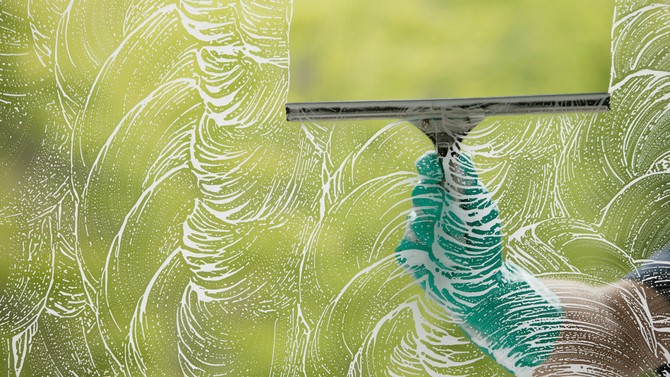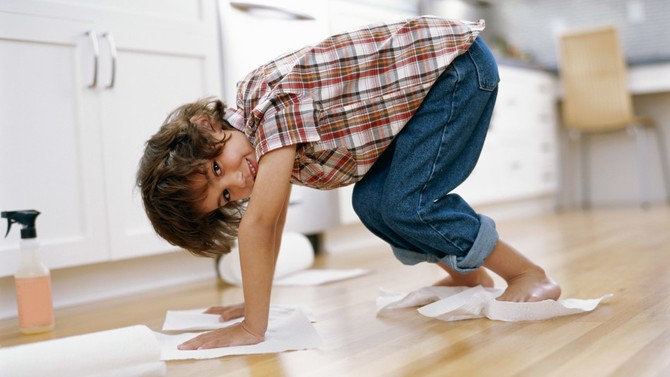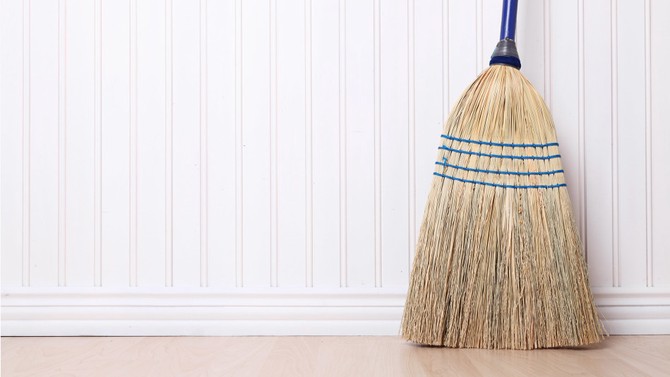Our Favorite Cleaning Secrets from the Pros
The need to clean can sneak up and overwhelm us in no time, and sometimes it's difficult knowing where to start. Here are the best (and easiest) pro tips to help break the cycle of cleaning inertia.
By Emily Lee

Photo: Francesco Cantone/EyeEm/Getty Images
With 60 seconds to quick clean, Becky Rapinchuk, Clean Mama blogger and author of The Organically Clean Home, would wipe down her bathroom sink because it's one of the first things you notice in a bathroom—especially if there are water marks or toothpaste gunk. If you have more time to spare, you might whip up her DIY chemical-free disinfecting spray: 1/2 cup white vinegar, 1/2 cup vodka (for germ-killing properties), 10 drops lavender essential oil, 10 drops lemon essential oil and 1 1/2 cups water (distilled or boiled and cooled). Spritz and come back in 10 minutes to rub down surfaces. (One more thing: If it's a pedestal sink don't forget to wipe down the front and sides, all the way to the floor.)
— Joann Pan

Photo: Andrew Rafalsky/iStock
Just as people like to peek inside closets, they also open refrigerators—and Jill Sloane, executive vice president of Halstead Property's Westside Office in Manhattan, is amazed at how many clean homes have dirty fridges. Spills that have become thick and sticky, funky smells and food piled every which way are the biggest problems she sees. Before you put ketchup, mustard or jelly away, wipe off the rim and bottom. Every few days, do a sweep for food that's past its prime. And give the fridge itself a good scrub regularly: Empty the contents, store them in a cooler, turn off the power and let the shelves and drawers come to room temperature before you wash them, since glass and ceramic parts could crack if they come into contact with hot water when they are cold.
— Lynn Andriani

Photo: Comstock/Getty Images
Here's something you don't ever want to do: cleaning windows in the hot sun. Direct sunlight can cause the cleaner to evaporate before it is wiped off, leaving those nasty streaks we all dread. So, the best time to clean your windows is in the morning or early evening when windows cool down. Try the touch test: If the window is hot to touch, then it's too hot to clean.
To clean your windows, apply cleaner to windows with a slightly dampened sponge and wipe the entire window. Then, with a squeegee, wipe across the window, cleaning the squeegee after each pass.
To clean up any drips, ditch the paper towel and use yesterday's newspaper instead.
— Frank Fontana

Photo: Kraig Scarbinsky/Getty Images
If your household is prone to drink and/or food spills, don't waste money going through containers upon containers of cleaning wipes. Instead, make your own for a fraction of the cost with Fabulessly Frugal's easy recipe, which includes items that are probably already lying around your kitchen: paper towels, vinegar, water, a few drops of dish soap and of an essential oil (although not necessary, the latter helps to mask the smell of vinegar). Then, store them in Tupperware, or in an old container of store-bought wipes, and you'll be a whole lot happier when you get your monthly bank statement.
— Pamela Masin

Photo: moodboard/Getty Images
Ink: Press a teaspoon of citric acid onto the spots (using a bone spoon) and moisten with water. Then pour boiling water over the stains until they disappear.
Wine or fruit: Stretch the fabric over a bowl and pour boiling water through it until the stain disappears.
Rust: Stewed rhubarb, spread over the stain, left for a few hours and washed off, is pretty effective. (Boiled fig leaves work just as well.)
Blood: Soak thoroughly in cold, salty water for an hour or so before washing.
Old coffee or tea stains: Can be soaked in a diluted solution of methylated spirits and 1/2 cup to 2 cups of water. Leave garments to soak for an hour and then wash as normal.
Scorch marks: Bruise two onions and then boil in 1/2 pint vinegar with some grated soap and 2 ounces of Fuller's Earth. When cooled, apply mixture to scorch mark and rinse off when dry.
Mildew: Soak for a few hours in buttermilk before washing.
— Lucy Lethbridge

Photo: MichellePatrickPhotographyLLC/iStock
If you've committed to marble countertops seen in home décor photos everywhere, you've noticed that even when yours are clean enough to eat off of, they can still look grimy. Marble is a porous material that soaks up spills after just 30 minutes, but those stains can also be removed, even if they're older, according to Fredrick Hueston, author of Stain Removal Guide for Stone, Tile and Concrete. For organic stains, mix hydrogen peroxide and flour to the consistency of peanut butter; for oil-based stains, use dishwashing liquid and flour. Spread the mixture over the stain and let it sit for 24 hours; then scrape it off with a putty knife. For truly stubborn stains, you might have to repeat the process.
— Kate Rockwood

Photo: Sadeugra/iStock
For quick cleanups, it's hard to beat a simple broom. You probably already know the difference between indoor brooms (they have finer bristles that work well on hardwood or tile) and outdoor brooms (their stiffer bristles can move larger pieces of debris on concrete or cement). Melissa Maker, host of the YouTube channel CleanMySpace, says angled indoor brooms are great at getting in tight corners. Once you've got the correct type of sweeper, use this advice from Cassandra Aarssen, of the cleaning site ClutterBug. Sweep toward you, instead of away, to help control the pile of debris and limit the amount of dust that rises up into the air. Start in the corners and sweep toward you in short, smooth motions. Then, use a dust pan often to avoid dragging your dirt piles across the clean floor.
— Lynn Andriani

Photo: djedzura/iStock
Completed daily, these tasks are the secret to keeping your home tidy—most of the time.
Make beds: Make your bed and teach the others in your home to make their beds too.
Check floors: Sweep/vacuum as needed with a broom, vacuum or microfiber floor duster.
Wipe counters: Wipe kitchen counters down after meals and check bathroom counters.
Declutter: Pick up clutter during the day and in the evening.
Do laundry: Complete one load of laundry from start to finish every day.
— Becky Rapinchuk

Photo: manushot/iStock
If you have a pet that sheds, you're probably accustomed to rolling a lint brush over your clothes and furniture daily. But if you've been taking a vacuum to your hardwood floors in an attempt to rid them of hair, chances are you're just blowing the mess around instead of picking it up. Jennifer Coates, a licensed veterinarian and contributor to petMD.com who once owned five dogs and four cats, says the vacuum's exhaust tends to push as much hair away as it cleans up. On wood and other hard floors, she says, use a big electrostatic mop (like Carlisle's Microfiber Dry Mop Pad), which won't create a lot of wind, so you can push the hair into a big pile. Then, pull out the vacuum—but use the wand attachment—to suck it up. You can also use the vacuum to clean the mop itself, or just toss it into the washing machine.
— Lynn Andriani

Photo: Courtesy of The Complete Book of Clean
Since tending to them thoroughly can typically add a lot more time to our cleaning routines, blinds and shutters get overlooked more often than not. Be sure to give them the attention they need whenever you clean, and get into the habit of properly cleaning them monthly.
Spot Clean
Using an all-purpose cleaner and a microfiber cloth or a specialty tool designed to clean blinds and shutters, wipe away dirt as needed.
Dust Monthly
Using a vacuum dust-brush attachment on the lowest setting, suction the dirt away. Glide the brush attachment horizontally (not vertically) along the blinds or shutters. Start at the top and move your way down; then reverse the blades and dust on the other side.
Deep Clean
If the dust has turned to gunk (as often happens in the kitchen, where steam and grease are in the air), it's time for a more thorough cleaning on removable blinds. Pull the blinds up all the way before lifting them off their supports, and they will be easier to transport. Using a soft sponge, briefly soak and wash them in the bathtub to remove grime. Rinse well and then lay them out on towels to completely dry before rehanging.
— Toni Hammersley
Published 07/19/2018

